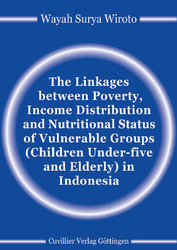| Fachbereiche | |
|---|---|
| Buchreihen (96) |
1379
|
| Nachhaltigkeit |
3
|
| Gesundheitswesen |
1
|
| Geisteswissenschaften |
2367
|
| Naturwissenschaften |
5407
|
| Mathematik | 229 |
| Informatik | 319 |
| Physik | 980 |
| Chemie | 1364 |
| Geowissenschaften | 131 |
| Humanmedizin | 243 |
| Zahn-, Mund- und Kieferheilkunde | 10 |
| Veterinärmedizin | 108 |
| Pharmazie | 147 |
| Biologie | 835 |
| Biochemie, Molekularbiologie, Gentechnologie | 121 |
| Biophysik | 25 |
| Ernährungs- und Haushaltswissenschaften | 45 |
| Land- und Agrarwissenschaften | 1004 |
| Forstwissenschaften | 201 |
| Gartenbauwissenschaft | 20 |
| Umweltforschung, Ökologie und Landespflege | 148 |
| Ingenieurwissenschaften |
1793
|
| Allgemein |
98
|
|
Leitlinien Unfallchirurgie
5. Auflage bestellen |
|
Erweiterte Suche
The Linkages between Poverty, Income Distribution and Nutritional Status of Vulnerable Groups (Children Under-five and Elderly) in Indonesia
Wayah Surya Wiroto (Autor)Vorschau
Inhaltsverzeichnis, Datei (38 KB)
Leseprobe, Datei (43 KB)
The aim of the study is to investigate the influences of poverty and income distribution to the nutritional status of children under-five and elderly in Indonesia using Indonesian Family Life Survey (IFLS) data sets. The poverty and income distribution analysis of the study used panel data sets of 1993 and 1997 (n=4854). The analysis on the effect of poverty and income distribution on nutritional status of children under-five (n=1626) and elderly (55+ years of age) (n=1377) used only the 1993 data set due to unavailability of health and nutritional data in the 1997 data set. The results of the poverty analysis showed, that the percentage of poor significantly increased from 39.6% to 45.5% in the period 1993 to 1997. Rural poverty was found to be worse-off compared to urban poverty in terms of head count index, poverty gap and severity of poverty. However, percentage of incidence of poverty was found to be significantly higher in urban areas. This finding correlates with the sensitivity of changes of urban poverty to the changes of poverty line which is elastic. On the other hand, rural poor was found to be inelastic to the changes in poverty line. It was concluded that female-headed household, unemployed, household size larger than four and education level less than six years are factors associated with poverty. Income inequality in urban areas was revealed to be slightly higher than rural areas. But, the changes from 1993 to 1997 implied that urban areas underwent a reduction in income inequality, at the same time as income inequality in rural areas rises. High income inequality measured by Gini ratio and Generalized Entropy Measure of Income Inequality can be explained by the fact, that 20% of the total respondents, that belong to the highest income level, accumulate more than 50% of the total income. Additionally, higher proportion of respondents who are female headed household, unemployed and having education less than six years shifted down to lower income quintile in the distribution from 1993 to 1997. The third part of the study presented results on the relationship between poverty, income distribution and nutritional status of children under-five. Boys were found to be shorter compared to girls. Children from rural areas are shorter and lighter compared to their urban counterparts. As the age progresses, the nutritional status of children underfive also deteriorates, meaning they are becoming shorter and lighter according to their age. Lower HAZ (Height for Age Z-score) was discovered among children under-five from poor households. Higher percentages of stunted and underweight children under-five were also prevalent among poor households. Furthermore, higher income level was associated with better HAZ and WAZ (Weight for Age Z-Score). Last, income level was revealed to be a positive predictor for HAZ and WAZ of children under-five. The last part of the empirical study shows that the majority of the poor are female elderly. Forty percent of elderly was considered to be undernourished (BMI less than 18.5). On the contrary, obesity was found to be significantly higher in female elderly with the highest proportion in the urban female elderly. The nutritional status of the poor elderly was discovered to be significantly lower than their non-poor counterpart. Elderly in the lower income level was significantly undernourished compared to their counterparts in the higher level of the income distribution. Poor elderly was also found to be significantly shorter and lighter compared to the non-poor counterpart. It was found, that poverty and income level were reliable predictors to the BMI status of elderly, as well as height and weight.
| ISBN-13 (Printausgabe) | 3898737063 |
| ISBN-13 (Printausgabe) | 9783898737067 |
| ISBN-13 (E-Book) | 9783736907065 |
| Sprache | Deutsch |
| Seitenanzahl | 260 |
| Auflage | 1 |
| Band | 0 |
| Erscheinungsort | Göttingen |
| Promotionsort | Göttingen |
| Erscheinungsdatum | 07.05.2003 |
| Allgemeine Einordnung | Dissertation |
| Fachbereiche |
Land- und Agrarwissenschaften
|








